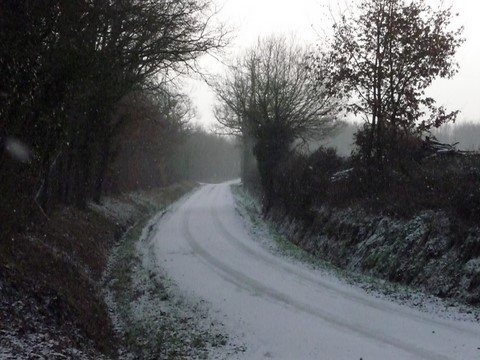The winters in the 1950s were long and arduous in La Guichardière, a village located in the parish of Tessonnière. We still remember the terrible month of February 1956 with temperatures in the -20º to -25º C range for most of the month. Also, snow was common at Christmas.
It was the season for family gatherings on the farms. Neighbors would meet to spend an evening together. The men would play cards, with “Trut” being the most popular game. The women would play games like “Les Petits Chevaux” (the small horses) and the game of “l’Oie” (the goose) which they would teach to the children. The children played together or listened to the grandfather seated near the fireplace. He would tell old-time stories from the past. But rarely would he reminisce about the Great War of 1914-1918.
Sometimes we would crack open and share some walnuts and hazelnuts. Approximately two weeks before Christmas, I would go into the forest of Tessionière, near the Thureau woods, the only area that had fir trees. I would cut off a bushy branch. I also collected holly and fine moss found beneath some oak trees. With the help of my mother, we made a display, covered it with garlands and placed it beside a manger scene at the base of the chimney.
Christmas eve and Christmas day were well celebrated in our countryside. In Tessonnière, we enjoyed midnight mass on Christmas eve and Christmas mass on Christmas day. I can still remember my neighbor Marie Marot, an elderly woman. On Christmas morning she would fill her “foot-warmers” with embers from her chimney. She would then set out on foot in the cold, all wrapped up in warm woolen clothing, wearing clogs in the snow. She would take the forest trail in order to reach the church, a kilometer away in Tessonnière. Once inside and seated, she would keep her feet warm despite the icy nave. (Obviously there was no central heating in those days). Other women did the same.

Route de La.. Guichardière
On Christmas eve, in preparation for the arrival of Père Noël (Father Christmas), families would place their Sunday-best shoes, all nice and shiny, in front of the chimney. The next morning, all would inevitably find an orange in their shoe. That was the gift. Children could also find a chocolate figurine or some other sweet treat.
On a very rare occasion, my neighbor and best friend Christian Jaunet, who was almost the same age as me, received some amazing toys for that era: a Meccano set and a toy train.
The Christmas feast was almost always the same from year to year. So each Christmas was celebrated with simplicity. And the same could be said for New Year’s day, where children would go knocking on doors and wishing everyone: “Happy new year, good health and paradise at the end of your days!” The villagers would give them a small coin (a franc) or some candy. The children then went to the grocery store to buy soft caramels worth one franc.
This is how we lived before the advent of television and the telephone. Christmas was less celebrated than Easter, which was the highest religious day of the year. Families would come together at that time and the women prepared a huge meal. The dessert was a “Le Broyé” cake from Poitou and would be served with homemade liqueurs. That’s how we celebrated a great family holiday at springtime.
In conclusion, I will share with you two old sayings from Poitou and our Gâtine:
“Lune blanche à Noël, bon grain à ramasser.” (Full moon at Christmas, good grain for harvest)
“Les hivers les plus froids sont ceux qui prennent aux Rois. » (The coldest winters are those that start at the feast of the Wise Men).
We used to say that the first six days of January would predict the kind of weather that we would see in the first six months of the year. Also we would say that the last six days would be a forecast of the last six months.
Nativity scene on the porch of the old church of Tessoniere in 2011